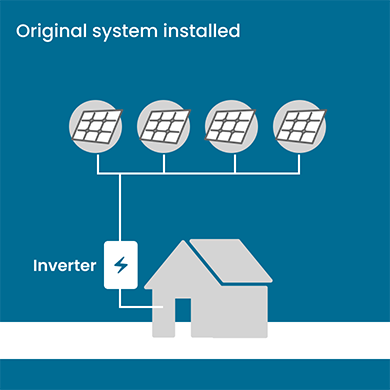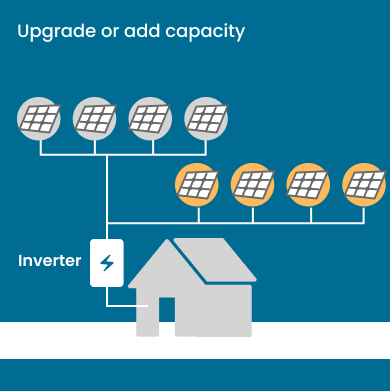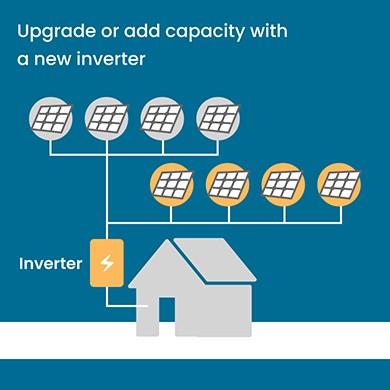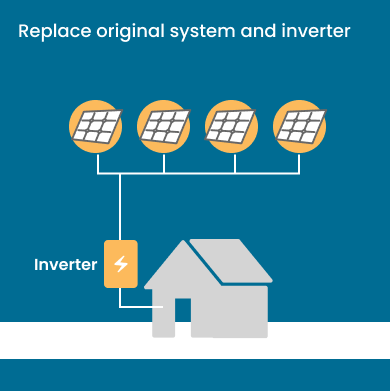When you install an eligible small-scale renewable energy system at your home or business, you may be eligible to earn financial incentives.
Before you install a renewable energy system, make sure you understand:
- what type of system you should install
- the installation requirements
- which systems and components are eligible
- which installers and designers are approved under the Small-scale Renewable Energy Scheme.
Types of small-scale renewable energy systems
There are 6 types of small-scale renewable energy systems eligible under the scheme:
- solar photovoltaic (PV)
- solar batteries
- wind turbines
- hydro systems
- solar water heaters
- air source heat pumps.
Classification of a small-scale system is based on the system's capacity or how much energy the system displaces. Systems that generate electricity (not displace or store like solar batteries, solar water heaters and air source heat pumps) with higher capacity may be classified as power stations. Power stations can be accredited under the Large-scale Renewable Energy Target and may be eligible for large-scale generation certificates.
System capacity: no more than 100 kW.
Annual electricity output: less than 250 MWh.
Find out more about installing rooftop solar.
System capacity: up to 700 L.
Models with a capacity over 700 L need further documentation to be eligible for STCs.
Find out more about installing solar water heaters.
System capacity: no more than 425 L.
Find out more about installing air source heat pumps.
System capacity: no more than 10 kW.
Annual electricity output: less than 25 MWh.
Find out more about small-scale wind systems.
System capacity: no more than 6.4 kW.
Annual electricity output: less than 25 MWh.
Find out more about small-scale hydro systems.
Solar batteries are eligible under the scheme from 1 July 2025.
The solar battery’s nominal capacity must be no less than 5 kWh and no more than 100 kWh inclusive. This includes modular solar battery installations.
Find out more about solar batteries.
New systems
To be eligible for STCs, newly installed small-scale systems must meet certain requirements.
Small generation units
A solar PV, solar battery, wind or hydro system must:
- have STCs created within 12 months of the installation
- have its panels, batteries or inverters listed on the Clean Energy Council (CEC) list of approved components
- meet Australian and New Zealand standards
- be designed and installed by a Solar Accreditation Australia (SAA) accredited designer and installer appropriately accredited for the installation type
- meet SAA design and install guidelines
- comply with all local, state, territory and federal requirements, including electrical safety
- be classified as small-scale.
Solar water heater systems
Solar hot water systems and air source heat pumps must:
- be listed on the register of solar water heaters
- have STCs created within 12 months of the installation.
Find out more about how to install a solar water heater.
Expanding, upgrading or replacing existing solar PV systems
You should consider your options and compare the benefits and costs of installing a new or expanded system. This includes:
- electrical wiring upgrades
- compliance with current standards
- operating efficiency
- hidden costs of changes or upgrades
- impacts on feed-in tariffs.
If you are expanding a system, you may need to replace or upgrade components of your system to participate in the scheme. It's important to note that systems with replaced panels that previously received STCs aren't eligible for additional STCs.
Expanding systems and claiming STCs
If you expand your system before your initial claim for STCs is approved, you risk not being able to claim any STCs for the system. For example, if your initial STC claim for a small-scale system fails, you may not be able to re-create STCs for an expanded system above 100 kW.
Find out more about upgrading a small-scale system.
We have provided some examples to help you determine if your new system, or updates to an existing system, is eligible.
A home installs a rooftop solar system with approved inverter and panels.

A home uses an existing inverter to add more panels to its rooftop solar system.
The upgrade will be eligible if:
- the total system capacity after the upgrade has a rating of no more than 100 kW
- the new panels and existing inverter are on the CEC approved products list
- the inverter has sufficient capacity
- all components meet the current relevant standards.
Systems that have a capacity increased to more than 100 kW may be eligible to apply for accreditation as a power station. Find out more about upgrading a small-scale system to a power station.

A home adds a new inverter and new panels to an existing system.
The existing panels are in good condition, so the householder wants to connect both the existing panels and the new panels to the new inverter. STCs have already been claimed for the existing system.
The upgrade will be eligible if:
- the total system capacity after the upgrade has a rating of no more than 100 kW
- the new panels and new inverter are on the CEC approved products list
- the new inverter has sufficient capacity
- all components meet the current relevant standards
- the system meets all relevant state and territory laws, including electrical safety regulations
- the existing panels are not included in the new claim for STCs.
Re-certifying the system
Australian Standards and solar PV panels have changed over time. Installers and designers should ensure they consider what, if any, redesign of the existing system is needed and make sure the homeowner is informed.
Installers must confirm and re-certify the entire system, including the connection to the electrical installation, as safe, compliant and meeting all requirements.
Installers and designers must upgrade any components no longer meeting requirements.

A house has an existing rooftop solar system. They install an additional inverter and new panels.
The additional system will be eligible if:
- the combined capacity of the systems has a rating of no more than 100 kW
- the new panels and new inverter are on the CEC approved products list
- all components meet the current relevant standards.

A house replaces its original rooftop solar system in its entirety. This includes removing the original system to install a new inverter and panels.
The new system will be eligible if:
- the system has a rating of no more than 100 kW
- the panels and inverter are new, with no previous STC claims
- the new panels and new inverter are on the CEC approved products list at the time of installation
- all components meet the current relevant standards.

A house replaces some of the panels in its existing rooftop solar system. It continues to use existing system components, including the inverters.
This system update is not eligible for STCs. This is because the inverter and some panels have previously been used to claim STCs.

Small-scale technology certificate eligibility for recalled products
For a small-scale renewable energy system to be eligible to claim STCs, the system must meet the requirements under the Renewable Energy (Electricity) Act 2000 and the Renewable Energy (Electricity) Regulations 2001. Under the Regulations, a product model is ineligible for STCs if it's subject to a recall under Australian Consumer Law.
We'll communicate with industry following a recall notice publication from the Australian Competition and Consumer Commission (ACCC). The product recall notice will include instructions for repairing or replacing the product.
We may consider a product eligible for STCs if you repair or replace it as outlined in the recall notice.
You should contact the manufacturer to arrange the repair. Once repaired, send evidence of the repair and the product serial number to the manufacturer. The manufacturer will pass these details to us to consider STC processing.
If you have questions about a recalled product, contact the manufacturer or the Australian Competition and Consumer Commission.
Current recalled products
- Sigenergy Australia Pty Ltd (inverter)
- Chromagen Australia Pty Ltd (heat pump water heater)
- GoodWe Australia Pty Ltd (inverter)
- Growatt New Energy Australia Pty Ltd (inverter)
- GoodWe Australia Pty Ltd (inverter)
- Jinko Solar Holdings Co. Pty Ltd (inverter)
- LG Energy Solution Australia Pty Ltd (battery)
For support, email us at deemedunits@cer.gov.au or contact us.
Sigenergy recall information
The ACCC issued a recall notice for Sigenergy single phase 8/10/12 kilowatt inverters on 19 November 2025. The recall covers products sold 04 March 2025 to 18 November 2025.
Consumers will receive a notification via the mySigen app if their product is affected by the recall. Consumers should ensure their systems are connected to the internet so they can receive a firmware update to allow Sigenergy to update and monitor their system proactively.
Consumers will receive a free replacement product that has an updated AC plug and will be contacted by their retailer or Sigenergy Australia service partner to arrange replacements.
We are working closely with Sigenergy to process applications for small-scale technology certificates.